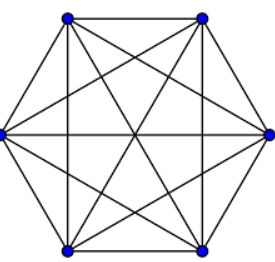
How many triangles can be formed by joining the vertices of a hexagon?
A. 31
B. 25
C. 20
D. 60
Answer
576.9k+ views
Hint: As we know that hexagon has \[6\] vertices means \[6\] points and the triangle has \[3\] points means a triangle need \[3\] vertices to be formed. Then, the numbers of triangles that can be formed by joining the vertices of a hexagon can be calculated by applying the concept of combination.
Complete step by step solution:

The number of vertices in a hexagon is \[6\].
The number of vertices in a triangle is \[3\].
That means to make a triangle we need \[3\] vertices.
So,\[6\]is the total number of vertices in hexagons, and out of those 6 vertices, 3 vertices that being chosen at a time to make a triangle.
By applying the formula of combination:
\[{}^n{C_r} = \dfrac{{n!}}{{r! \times \left( {n - r} \right)!}}\] where, n is the total numbers of objects and r is the number of objects to be chosen as a time.
Therefore,
\[{}^6{C_3} = \dfrac{{6!}}{{3! \times \left( {6 - 3} \right)!}} = \dfrac{{6!}}{{3! \times \left( 3 \right)!}}\]
By using the values of factorial terms:
We have, \[6!\] can be written as \[6 \times 5 \times 4 \times 3 \times 2 \times 1\] and \[3!\] can be written as \[3 \times 2 \times 1.\]
Replace \[6!\] = \[6 \times 5 \times 4 \times 3 \times 2 \times 1\] and \[3!\]= \[3 \times 2 \times 1\] in the following equation,
\[
{}^6{C_3} = \dfrac{{6!}}{{3! \times \left( 3 \right)!}} \\
= \dfrac{{6 \times 5 \times 4 \times 3 \times 2 \times 1}}{{3 \times 2 \times 1\left( {3 \times 2 \times 1} \right)}} = \dfrac{{120}}{6} = 20 \\
\]
$\therefore$ The number of triangles that can be formed by joining the vertices of a hexagon is \[20\]. Hence, option (C) is correct.
Note:
These types of questions always use a combination concept for solving the problem.
Some important definitions you should know
Vertices mean the point where \[2\] or more lines meet.
Combination: Any of the ways we can combine things when the order does not matter.
Combination formula: The formula of combination is \[{}^n{C_r} = \dfrac{{n!}}{{r! \times \left( {n - r} \right)!}}\], where \[n\] represents the number of items and \[r\] represents the number of the items that being chosen at a time.
The factorial function\[(!)\]: The factorial function means to multiply all whole numbers from the chosen numbers down to \[1\].
The representation of factorial is \[n!\].
Alternatively, you can draw the figure and count the triangles but it becomes complicated.
Complete step by step solution:

The number of vertices in a hexagon is \[6\].
The number of vertices in a triangle is \[3\].
That means to make a triangle we need \[3\] vertices.
So,\[6\]is the total number of vertices in hexagons, and out of those 6 vertices, 3 vertices that being chosen at a time to make a triangle.
By applying the formula of combination:
\[{}^n{C_r} = \dfrac{{n!}}{{r! \times \left( {n - r} \right)!}}\] where, n is the total numbers of objects and r is the number of objects to be chosen as a time.
Therefore,
\[{}^6{C_3} = \dfrac{{6!}}{{3! \times \left( {6 - 3} \right)!}} = \dfrac{{6!}}{{3! \times \left( 3 \right)!}}\]
By using the values of factorial terms:
We have, \[6!\] can be written as \[6 \times 5 \times 4 \times 3 \times 2 \times 1\] and \[3!\] can be written as \[3 \times 2 \times 1.\]
Replace \[6!\] = \[6 \times 5 \times 4 \times 3 \times 2 \times 1\] and \[3!\]= \[3 \times 2 \times 1\] in the following equation,
\[
{}^6{C_3} = \dfrac{{6!}}{{3! \times \left( 3 \right)!}} \\
= \dfrac{{6 \times 5 \times 4 \times 3 \times 2 \times 1}}{{3 \times 2 \times 1\left( {3 \times 2 \times 1} \right)}} = \dfrac{{120}}{6} = 20 \\
\]
$\therefore$ The number of triangles that can be formed by joining the vertices of a hexagon is \[20\]. Hence, option (C) is correct.
Note:
These types of questions always use a combination concept for solving the problem.
Some important definitions you should know
Vertices mean the point where \[2\] or more lines meet.
Combination: Any of the ways we can combine things when the order does not matter.
Combination formula: The formula of combination is \[{}^n{C_r} = \dfrac{{n!}}{{r! \times \left( {n - r} \right)!}}\], where \[n\] represents the number of items and \[r\] represents the number of the items that being chosen at a time.
The factorial function\[(!)\]: The factorial function means to multiply all whole numbers from the chosen numbers down to \[1\].
The representation of factorial is \[n!\].
Alternatively, you can draw the figure and count the triangles but it becomes complicated.
Recently Updated Pages
Why are manures considered better than fertilizers class 11 biology CBSE

Find the coordinates of the midpoint of the line segment class 11 maths CBSE

Distinguish between static friction limiting friction class 11 physics CBSE

The Chairman of the constituent Assembly was A Jawaharlal class 11 social science CBSE

The first National Commission on Labour NCL submitted class 11 social science CBSE

Number of all subshell of n + l 7 is A 4 B 5 C 6 D class 11 chemistry CBSE

Trending doubts
What is meant by exothermic and endothermic reactions class 11 chemistry CBSE

10 examples of friction in our daily life

One Metric ton is equal to kg A 10000 B 1000 C 100 class 11 physics CBSE

1 Quintal is equal to a 110 kg b 10 kg c 100kg d 1000 class 11 physics CBSE

Difference Between Prokaryotic Cells and Eukaryotic Cells

What are Quantum numbers Explain the quantum number class 11 chemistry CBSE




